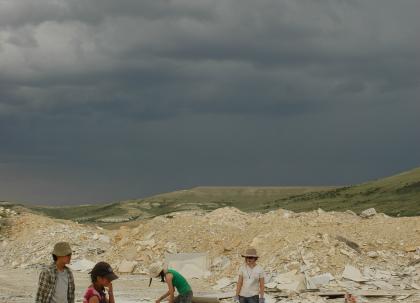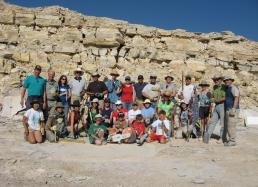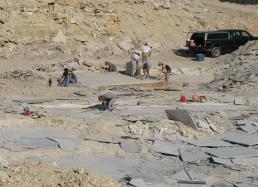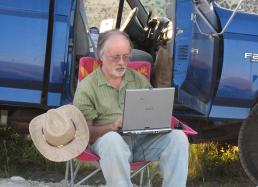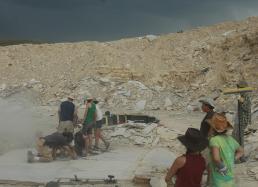5: Goodbye to Some, and Where Did The Sun Go?
Today and tomorrow, about half of our expedition team will be leaving. At its peak, the team included 31 members (see Photo #1 below). The half that is returning to beds and hot showers consists of several families that came as volunteers to supplement the core work force of students and Museum staff.
Leaving today and tomorrow will be the Kurtz family (with Field Museum Trustee, Randy Kurtz, and his daughter Eva), the Crawford family (with Field Museum Trustee, Bob Crawford, and his son Bob, and his two grandchildren, Peter and Andrew), the Gieser family (with Museum Founder's Council member Steve Gieser, his wife Ruth, and daughter Ellen), and the Augustyn family (with Museum Exhibit Developer Allison Augustyn, and her sister Jessie, and brother Ryan).
For the next week, it will be just the Museum staff, the Geology Department volunteers, and the "Stones and Bones" students, diehards to the end. For the rest of the trip, we'll focus on the main slab of limestone, which has been the most productive of the blocks we've been working this last week.
The students are becoming experts at working these limestone blocks, and their enthusiasm, energy, and focus only seems to increase with time (see Photo #2 below.) This is one sharp bunch. As we work the main block down, layer by layer, the students are conducting a survey of the fishes we find. Each layer is sketched, and the orientation and species of each fish is indicated on a series of quarry maps. By doing this, we hope to get additional information on which are the most common species, and possibly on the existence of bottom-current changes over time that might be indicated by the orientation of the fishes at each level.
We started taking this information at what we call the "orange marker bed"-a thin (one-eighth inch) orange layer marking a major volcanic eruption in the lake's history—which gives us a time point of reference to use in tying all of the different quarry levels on the different butte tops together.
In the Early Eocene when Fossil Lake existed, there were active volcanoes surrounding the lake, and at times there were massive eruptions resulting in widespread ash falls and huge forest fires (indicated by volcanic minerals and charred plant material). These eruptions must have killed millions of fishes, because the orange layer is associated with a mass mortality layer of millions of fossil fishes.
As I sit beside the quarry typing this dispatch on a laptop computer (see Photo #3 below), there are some heavy clouds moving in. Rain. Not what we want, camping out here on the butte top. If it rains too much (e.g. more than a day), the roads to and from the quarry become impassable, and we could become stranded here for a few days, unable to dig fossils.
Fossils will have to be covered with a plastic tarp so that they're not destroyed in the rain, and we'll have to suspend operations until the slab dries out (see top photo.) The limestone doesn't split properly when it's wet. If there's lightning, we'll wait in the cars and trucks because our tents are the highest points on the butte and can become effective lightning rods. Time to start preparing camp for the possibility of a storm.
More later,
Lance

